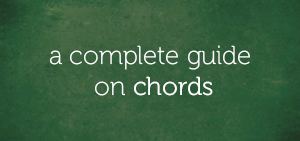In today’s lesson, we’ll be looking at the classes of extended chords.
It’s important for any serious musician to learn about extended chords because they are harmonically ahead of other chord classes like triads and seventh chords.
Having covered extended chords in a previous lesson, let’s go ahead and explore the three classes of extended chords.
A Quick Review On Extended Chords
Preliminaries
According to Jermaine Griggs, “a chord is basically a collection of three or more related notes (agreeable or not), which may be played or heard together.”
It takes at least three notes to form a chord, and the notes of the chord must be related to a given scale (scale relationship) and interval (intervallic relationship.)
In the C major triad:
…the notes C, E, and G, are related to the C natural major scale (scale relationship):
…and third intervals (intervallic relationship):
This explains why C to E:
…and E to G:
…are third intervals.
“What Is An Extended Chord?”
A chord can be classified as an extended chord if its width exceeds the compass of an octave.
Using the note C (as a reference):
We’ll have C to C:
…as an octave.
All chords with this C note (as their root):
…that exceed the compass of its octave (C to C):
…are classified as extended chords because their width are literally extending beyond the compass of an octave.
The Formation Of Extended Chords
Pursuant to traditional chord formation guidelines, anyone can form chords in third intervals (intervallic relationship) using a given scale.
Using the C natural major scale:
…a chord can be formed in third intervals – from C:
…to a third above C (which is E):
…to a third above C-E (which is G):
At this point, we’ve formed the C major triad:
Adding another third to C-E-G:
…(which is B):
…produces the C major seventh chord:
Adding another third to C-E-G-B:
…(which is D):
…produces an extended chord – the C major ninth chord:
Adding another third to C-E-G-B-D:
…(which is F):
…produces an extended chord – the C major eleventh chord:
Adding another third to C-E-G-B-D-F:
…(which is A):
…produces an extended chord – the C major thirteenth chord:
“In A Nutshell…”
Beyond the level of seventh chords are extended chords. This means that adding a note to a seventh chord, that is a third above it, produces an extended chord.
There are three distinct classes of extended chords and that’s our focus in this lesson. Join me in the next segment so we can discuss elaborately on it.
The Classes Of Extended Chords – Explained
All extended chords belong to one of these three classes:
Ninth chords
Eleventh chords
Thirteenth chords
Take a closer look at these chord classes.
Ninth Chords
Ninth chords are extended chords that encompass a ninth interval from their root.
In the key of C major:
…a ninth chord should encompass C to D:
…a ninth interval.
Beyond the size of a ninth chord, it’s important to also take a look at its chord tones which are:
The root
The third
The fifth
The seventh
The ninth
A ninth chord consists of five chord tones and can also be considered as a seventh chord with a ninth tone.
There are various ninth chord qualities which include (but isn’t limited to):
The major ninth chord
The minor ninth chord
The dominant ninth chord
The minor-major ninth chord
The diminished major ninth
Final Words
There are basically three classes of extended chords:
- Ninth chords
- Eleventh chords
- Thirteenth chords
…of various qualities – major, minor, dominant, etc., and we’ll explore them in subsequent lessons.
Thank you for your time.
Chuku Onyemachi
Latest posts by Chuku Onyemachi (see all)
- The Formation Of Diminished Seventh Chords Used To Be Challenging Until I Did This
- How To Form Seventh Chords In Two Shakes Of A Dog’s Tail Using Third Intervals And The Circle Of Fifths Chart
- I Played The 13sus4 Chord And This Happened…
- How To Build Seventh Chords Like An Architect Using “Foundation And Structure” Concept
- This 4-Week Plan Will Help You Master All The Major Scales







Comments on this entry are closed.